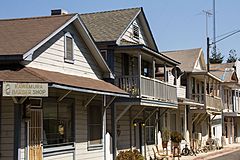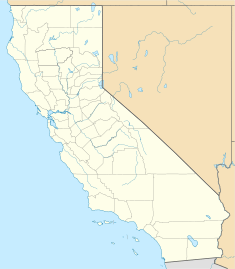Walnut Grove Japanese-American Historic District facts for kids
Quick facts for kids |
|
|
Walnut Grove Japanese-American Historic District
|
|

Kawamura Barber Shop on B Street in the Japanese-American Historic District
|
|
| Location | Approximately bounded by Winnie St, Tyler St, C St and River Rd. |
|---|---|
| Nearest city | Walnut Grove |
| Area | 5 acres (2.0 ha) |
| Built | c.1916 |
| Architectural style | Craftsman |
| NRHP reference No. | 90000483 |
| Added to NRHP | March 22, 1990 |
The Walnut Grove Japanese-American Historic District is a special area in Walnut Grove, California. It covers about 5 acres. This district is important because it shows how Japanese-American communities lived and built their lives in the early 1900s. Most of the buildings you see here today were built around 1915-1916. This was after a big fire destroyed the nearby Chinatown.
In 1942, during World War II, many Japanese and Japanese-Americans were forced to leave their homes. They had to move to special camps. This happened because of something called Executive Order 9066. After they left, Filipino and Mexican workers moved into the district. They helped with farming in the area.
After the war, many original residents came back to Walnut Grove. But most of them later moved to bigger cities. Even so, the district still looks much like it did in 1916. It keeps its original buildings and style.
Contents
History of Walnut Grove's Japantown
Early Japanese Immigration
After 1882, more people started coming to the United States from Japan. In Walnut Grove, the first Japanese-owned business opened in 1896. It was a noodle shop that served the new immigrants.
Building a New Community
In 1916, a part of Walnut Grove called Kawashimo was rebuilt. This happened after a fire in 1915. The new area was built one block north. It was on land owned by a local banker named Alex Brown.
Unlike other Japanese towns, or nihonmachi, in the area, Japanese people designed and built the new Kawashimo. Some even came from far away, like San Francisco, to help. Many new buildings had two floors. Families lived upstairs and ran their businesses on the ground floor.
Life in Japantown
By the 1920s, Kawashimo became a busy center for Japanese residents. It served over 100 families in the Sacramento River Delta area by the 1930s.
By 1920, almost 400 American-born children lived in the area. Some went to a local Japanese language school. In 1921, California allowed separate schools for different groups. This led to "Oriental Schools" in places like Walnut Grove. These schools were not officially mixed until 1947.
Changes During World War II
During World War II, the district became empty. Japanese and Japanese-American residents were forced to leave their homes. They were sent to special camps. After they left, Filipino and Mexican workers moved in. They took over the jobs in local farms.
Three buildings in the district were destroyed by fire during the war. They were never rebuilt. Some of these empty spots later became community gardens.
After the War
After the war ended, many original residents came back to Walnut Grove. However, most of them did not stay long. They found better opportunities in nearby cities.
Even in 1990, some businesses were still owned by the same families who started them. These included the Kawamura Barber Shop and Hayashi Market. The historic district still looks very much like it did in photographs from the 1920s.


